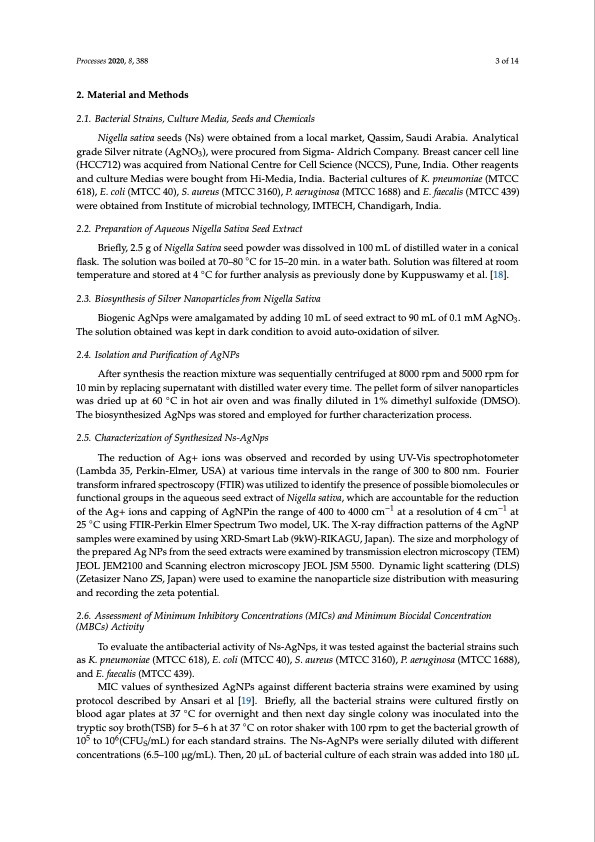
PDF Publication Title:
Text from PDF Page: 003
Processes 2020, 8, 388 3 of 14 2. Material and Methods 2.1. Bacterial Strains, Culture Media, Seeds and Chemicals Nigella sativa seeds (Ns) were obtained from a local market, Qassim, Saudi Arabia. Analytical grade Silver nitrate (AgNO3), were procured from Sigma- Aldrich Company. Breast cancer cell line (HCC712) was acquired from National Centre for Cell Science (NCCS), Pune, India. Other reagents and culture Medias were bought from Hi-Media, India. Bacterial cultures of K. pneumoniae (MTCC 618), E. coli (MTCC 40), S. aureus (MTCC 3160), P. aeruginosa (MTCC 1688) and E. faecalis (MTCC 439) were obtained from Institute of microbial technology, IMTECH, Chandigarh, India. 2.2. Preparation of Aqueous Nigella Sativa Seed Extract Briefly, 2.5 g of Nigella Sativa seed powder was dissolved in 100 mL of distilled water in a conical flask. The solution was boiled at 70–80 ◦C for 15–20 min. in a water bath. Solution was filtered at room temperature and stored at 4 ◦C for further analysis as previously done by Kuppuswamy et al. [18]. 2.3. Biosynthesis of Silver Nanoparticles from Nigella Sativa Biogenic AgNps were amalgamated by adding 10 mL of seed extract to 90 mL of 0.1 mM AgNO3. The solution obtained was kept in dark condition to avoid auto-oxidation of silver. 2.4. Isolation and Purification of AgNPs After synthesis the reaction mixture was sequentially centrifuged at 8000 rpm and 5000 rpm for 10 min by replacing supernatant with distilled water every time. The pellet form of silver nanoparticles was dried up at 60 ◦C in hot air oven and was finally diluted in 1% dimethyl sulfoxide (DMSO). The biosynthesized AgNps was stored and employed for further characterization process. 2.5. Characterization of Synthesized Ns-AgNps The reduction of Ag+ ions was observed and recorded by using UV-Vis spectrophotometer (Lambda 35, Perkin-Elmer, USA) at various time intervals in the range of 300 to 800 nm. Fourier transform infrared spectroscopy (FTIR) was utilized to identify the presence of possible biomolecules or functional groups in the aqueous seed extract of Nigella sativa, which are accountable for the reduction of the Ag+ ions and capping of AgNPin the range of 400 to 4000 cm−1 at a resolution of 4 cm−1 at 25 ◦C using FTIR-Perkin Elmer Spectrum Two model, UK. The X-ray diffraction patterns of the AgNP samples were examined by using XRD-Smart Lab (9kW)-RIKAGU, Japan). The size and morphology of the prepared Ag NPs from the seed extracts were examined by transmission electron microscopy (TEM) JEOL JEM2100 and Scanning electron microscopy JEOL JSM 5500. Dynamic light scattering (DLS) (Zetasizer Nano ZS, Japan) were used to examine the nanoparticle size distribution with measuring and recording the zeta potential. 2.6. Assessment of Minimum Inhibitory Concentrations (MICs) and Minimum Biocidal Concentration (MBCs) Activity To evaluate the antibacterial activity of Ns-AgNps, it was tested against the bacterial strains such as K. pneumoniae (MTCC 618), E. coli (MTCC 40), S. aureus (MTCC 3160), P. aeruginosa (MTCC 1688), and E. faecalis (MTCC 439). MIC values of synthesized AgNPs against different bacteria strains were examined by using protocol described by Ansari et al [19]. Briefly, all the bacterial strains were cultured firstly on blood agar plates at 37 ◦C for overnight and then next day single colony was inoculated into the tryptic soy broth(TSB) for 5–6 h at 37 ◦C on rotor shaker with 100 rpm to get the bacterial growth of 105 to 106(CFUS/mL) for each standard strains. The Ns-AgNPs were serially diluted with different concentrations (6.5–100 μg/mL). Then, 20 μL of bacterial culture of each strain was added into 180 μLPDF Image | Silver Nanoparticles Seed Extract Nigella sativa blackseed

PDF Search Title:
Silver Nanoparticles Seed Extract Nigella sativa blackseedOriginal File Name Searched:
processes-08-00388-v2.pdfDIY PDF Search: Google It | Yahoo | Bing
Turbine and System Plans CAD CAM: Special for this month, any plans are $10,000 for complete Cad/Cam blueprints. License is for one build. Try before you buy a production license. More Info
Waste Heat Power Technology: Organic Rankine Cycle uses waste heat to make electricity, shaft horsepower and cooling. More Info
All Turbine and System Products: Infinity Turbine ORD systems, turbine generator sets, build plans and more to use your waste heat from 30C to 100C. More Info
CO2 Phase Change Demonstrator: CO2 goes supercritical at 30 C. This is a experimental platform which you can use to demonstrate phase change with low heat. Includes integration area for small CO2 turbine, static generator, and more. This can also be used for a GTL Gas to Liquids experimental platform. More Info
Introducing the Infinity Turbine Products Infinity Turbine develops and builds systems for making power from waste heat. It also is working on innovative strategies for storing, making, and deploying energy. More Info
Need Strategy? Use our Consulting and analyst services Infinity Turbine LLC is pleased to announce its consulting and analyst services. We have worked in the renewable energy industry as a researcher, developing sales and markets, along with may inventions and innovations. More Info
Made in USA with Global Energy Millennial Web Engine These pages were made with the Global Energy Web PDF Engine using Filemaker (Claris) software.
Infinity Turbine Developing Spinning Disc Reactor SDR or Spinning Disc Reactors reduce processing time for liquid production of Silver Nanoparticles.
| CONTACT TEL: 608-238-6001 Email: greg@infinityturbine.com | RSS | AMP |